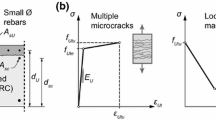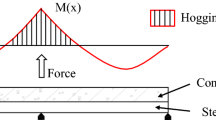Abstract
The constant demand of LWAC applications in structural engineering increases the need of performing studies focused on the behavior of reinforced members produced with LWAC. Mainly, by combining reduced weight and good mechanical performance, LWAC is an efficient solution for flat slabs. The design methods of punching shear strength of LWAC slabs are commonly based on experimental studies of NWC. However, both the stress–strain relation and the distribution of internal stresses of LWAC are quite different from those of NWC, due to the stiffness compatibility between the binding matrix and the LWA, and due to the enhanced performance of interfacial transition zone LWA-matrix. This behavior influences the distribution of internal stresses of LWAC, when compared with NWC, and results in a linear stress–strain relation until around 90 % of maximum stress and a brittle failure after peak when unconfined (Costa in, Lightweight aggregate structural concrete: precast and strengthening of existing structures, 2012). This difference is ignored by the main structural concrete codes or the design expressions of NWC are modified by a corrective coefficient for LWAC, depending on its density. This paper presents an experimental study focused on punching capacity of LWAC slabs. Six slabs were produced with equal longitudinal reinforcement ratio and without shear reinforcement, varying the compressive strength of LWAC from 29 to 54 MPa. Based on the recorded data during the tests, the cracking and maximum loads, the displacements, rotations and stiffness, the failure modes and cracking patterns are presented and analyzed. Experimental results were compared with design predictions of main codes, namely, EC2, MC2010 and ACI318. The results revealed that the variation of LWAC strength influences the punching strength, but has no significant effect on the stiffness and on the angle of the main crack of punching cone. The evaluation of punching shear strength achieved by design methods is higher than the experimental results and, in the case of MC2010 with level I of approximation, is more than double. Excepting for EC2, the ratio between the maximum experimental punching strength and the corresponding code prediction decreases with the increase of LWAC strength.












Similar content being viewed by others
Abbreviations
- b :
-
Width of a cross-section
- d :
-
Effective depth of a cross-section
- d g :
-
Maximum aggregate size
- f ck :
-
Characteristic compressive cylinder strength of concrete at 28 days
- f lcm :
-
Mean value of compressive strength of LWAC
- f lctm :
-
Mean value of tensile strength of LWAC
- f y :
-
Yield strength of reinforcement
- f yd :
-
Design yield strength of reinforcement
- k I :
-
Stiffness corresponding to state I
- k II :
-
Stiffness corresponding to state II
- m Ed :
-
Average moment acting per unit length
- m Rd :
-
Average design resistant moment per unit length
- r s :
-
Position where bending moment is zero with respect to the column axis
- u :
-
Control perimeter
- u exp :
-
Experimental control perimeter
- u cod :
-
Control perimeter predicted by codes
- A s :
-
Cross-sectional area of tensile reinforcement
- C rd :
-
0.18/γ c and γ c is equal to 1.5
- E :
-
Young’s modulus of the material
- E s :
-
Young’s modulus of reinforcing steel
- P :
-
Applied load
- P actuator :
-
Load applied by servo-actuator
- P cr :
-
Cracking load
- P code :
-
Punching resistance predicted by codes
- P exp :
-
Maximum punching resistance recorded experimentally
- P max :
-
Maximum load supported
- V Rd,c :
-
Punching resistance in reinforced concrete slabs, without specific reinforcement
- α s :
-
Equal to 40 for interior columns, 30 for edge columns, 20 for corner columns
- β :
-
Ratio of long side to short side of the column, concentrated load or reaction area
- δ :
-
Vertical displacement
- δ cr :
-
Vertical displacement at cracking load
- δ max :
-
Vertical displacement at maximum load
- ψ :
-
Rotation of the slab
- ρ l :
-
Tensile reinforcement ratio, equal to A s/(b.d)
- ρ :
-
Concrete density
- θ :
-
Angle of the main crack
- ∅:
-
Diameter of a reinforcing bar
- η 1 :
-
Correction coefficient
References
Costa H (2012) Lightweight aggregate structural concrete: precast and strengthening of existing structures. University of Coimbra, Coimbra
EuroLightCon (1998) BE96-3942/R2: LWAC material properties. State-of-the-Art: European Union–Brite EuRam III
EuroLightCon (2000) BE96-3942/R22: The economic potential of lightweight aggregate concrete in c.i.p. concrete bridges: European Union–Brite EuRam III
Chandra S, Berntsson L (2002) Lightweight aggregate concrete. William Andrew, New York
Shafigh P, Hassanpour MH, Razavi SV, Kobraei M (2011) An investigation of the flexural behaviour of reinforced lightweight concrete beams. Int J Phys Sci 6(10):2414–2421
Jomaa MM, Daham HA, Rao SM (2011) Flexural behavior of lightweight concrete beams. Eur J Sci Res 58(4):582–592
Sin L, Huan W, Islam M, Mansur M (2011) Reinforced lightweight concrete beams in flexure. ACI Struct J 108(1):3–12
Costa H, Júlio E, Lourenço J (2012) New approach for shrinkage prediction of high-strength lightweight aggregate concrete. Constr Build Mater 35:84–91
Cui HZ, Lo TY, Memon SA, Xu W (2012) Effect of lightweight aggregates on the mechanical properties and brittleness of lightweight aggregate concrete. Constr Build Mater 35:149–158
Badogiannis EG, Kotsovos MD (2014) Monotonic and cyclic flexural tests on lightweight aggregate concrete beams. Earthq. Struct 6(3):317–334
CEB/FIP (1991) Model Code 90-Design Manual. Comité Euro-International du Béton, Thomas Telford
fib (2013) Model code for concrete structures 2010. International Federation for Structural Concrete, Wilhelm Ernst & Sohn
CEN (2004) EN 1992-1-1: Eurocode 2: Design of concrete structures—Part 1-1: General rules and rules for buildings. European Committee for Standardization (CEN)
ACI Committee (2008) 318: ACI 318R-08, Building Code Requirements for Structural Concrete and Commentary; ACI—American Concrete Institute; Farmington Hills
Hawkins NM, Fallsen HB, Hinojosa RC (1971) Influence of column rectangularity on the behavior of flat plate structures. ACI Publ Crack Deflection Ultim Load Concr Slab Syst 30(6):127–146
Richart FE (1948) Reinforced concrete wall and column footings. ACI J 45(10):97–127
Sacramento PVP et al (2012) Punching strength of reinforced concrete flat slabs without shear reinforcement. Ibracon Struct Mater J 5(5):659–691
Regan PE (1981) Behavior of reinforced concrete flat slabs, Report 89. Construction Industry Research and Information Association (CIRIA)
Marzouk H, Hussein A (1991) Experimental investigation on the behavior of high-strength concrete slabs. ACI Struct J 88(6):701–713
Hawkins NM, Criswell ME, Roll F (1974) Shear strength of slabs without shear reinforcement. ACI Publ Shear Reinf Concr 42(30):677–720
Regan PE (1986) Symmetric punching of reinforced concrete slabs. Mag Concr Res 38(136):115–128
Menétrey P (1996) Analytical computation of the punching strengh of reinforced concrete. ACI Strut J 93:503–511
Muttoni A, Schwartz J (1991) Comportement des poutres et poinçonnement des dalles sans armatures d´effort trenchant. IABSE Colloq 62:703–708
Muttoni A (2008) Punching shear strength of reinforced concrete slabs without transverse reinforcement. ACI Struct J 105(4):440–450
Al-Salloum YA, Alsayed SH (2013) Prediction of punching shear strength of HSC interior slab-column connections. KSCE J Civ Eng 17(2):473–485
Di Prisco M, Felicetti R (1997) Some results on punching shear in plain and fibre-reinforced micro-concrete slabs. Mag Concr Res 49(180):201–219
Tan KH, Paramasivam P (1994) Punching shear strength of steel fiber reinforced concrete slabs. J Mater Civ Eng 6(2):240–253
Maya LF, Fernández RM, Muttoni A, Foster SJ (2012) Punching shear strength of steel fibre reinforced concrete slabs. Eng Struct 40:83–94
McLean DI, Phan LT, White RN (1990) Punching shear behavior of lightweight concrete slabs and shells. ACI Struct J 87(4):386–392
Osman M, Marzouk H, Helmy S (2000) Behavior of high-strength lightweight concrete slabs under punching loads. ACI Struct J 97(3):492–498
Youm KS, Kim JJB, Moon JC (2014) Punching shear failure of slab with lightweight aggregate concrete (LWAC) and low reinforcement ratio. Constr Build Mater 65:92–102
EN 12390 (2009) Testing hardened concrete. European Committee for Standardisation (CEN)
EN 206-1 (2007) Concrete—Part 1: specification, performance, production and conformity. European Committee for Standardisation (CEN)
fib (2001) Technical report: punching of structural concrete slabs, Bulletin nº12. International Federation for Structural Concrete
Acknowledgments
The authors would like to express their gratitude to the Department of Civil Engineering of the Polytechnic Institute of Coimbra, for providing the conditions to carry out the experimental programme. Acknowledgments are also expressed to the following companies by the material supply: Secil, Saint-Gobain Weber, BASF, Argilis.
Author information
Authors and Affiliations
Corresponding author
Rights and permissions
About this article
Cite this article
Carmo, R.N.F., Costa, H. & Rodrigues, M. Experimental study of punching failure in LWAC slabs with different strengths. Mater Struct 49, 2611–2626 (2016). https://doi.org/10.1617/s11527-015-0671-x
Received:
Accepted:
Published:
Issue Date:
DOI: https://doi.org/10.1617/s11527-015-0671-x




